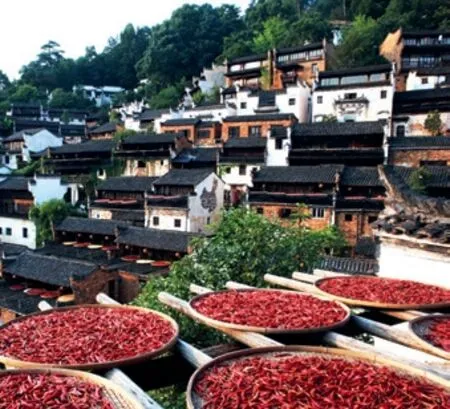Sleeping Beauty
How one village’s classic charm came to rise and shine again today By Tao Zihui
One early September morning, as the sun rose and the morning fog gradually dissipated, the rustic hillside village of Huangling began waking up. One resident took the peppers and corn bagged the night before from their shelves, and placed them on the long wooden brackets, under the roof eaves. Other neighbors, too, slowly filled their drying racks with harvested goods.
The mention of Jiangxi Province in east China might bring to mind the country’s world-famous capital of porcelain—Jingdezhen. Some 80 km east of Jingdezhen lies an ancient village that has gained popularity in recent years—Huangling in Wuyuan County.
Now is the best time of year to visit Huangling.In early autumn, large bamboo baskets are filled with crops, think chilies, pumpkins and chrysanthemum flowers, and placed in front of local doorsteps. This process is called, or “cropdrying,” the local agrarian custom of drying and preserving harvests for winter that has been passed down for generations in the region. Today,this longstanding practice has become a symbol of homegrown culture and a highlight of rural tourism.
Attracting some 1.45 million tourists a year,the community has also played a significant role in driving the development of surrounding villages.As a result, the World Tourism Alliance recognized Huangling as a successful case in tourismbased poverty reduction and China crowned it “the Demonstration Village of China’s Poverty-relief Rural Tourism.”
Who would’ve thought this quiet ancient village,famous for its, once faced the dilemma of winning or withering?
Retreat or revamp?
Huangling was once a rather dowdy setting of dilapidated houses and buildings. Before 2009, most young people would leave the village to seek better job opportunities in the bigger cities, leading their hometown to fall asleep. The beauty of its ancient buildings dating back to the Ming Dynasty (1368-1644) was on the verge of (literal) collapse due to long years of neglect. Difficulties in transportation, a lack of water and subsequently abandoned terraced fields didn’t help matters either. Daily life in the village suffered tremendously.
“When I saw that village in decay, I just thought,‘if we don’t rescue it, it will be gone completely a few years from now’,” Wu Xiangyang, head of Huangling Village, told.
To retreat or to revamp, that became the question.
Changes occurred when a series of restorations got underway from 2009 onward, with over 80 percent of tattered housing modernized.
Local authorities also launched an ambitious relocation program and were determined to preserve the Huizhou-style architecture, Wu said.
In 2009, Wuyuan County invested 12 million yuan ($1.67 million) in the construction of a settlement down the hill and relocated 320 villagers to their new home.
More than 100 ancient buildings were transported brick-by-brick from across the region and reconstructed in Huangling—with the help of traditional methods.
To support the development of the tourism industry, authorities poured a lot of capital into the region’s transport infrastructure. Cable cars and suspension bridges today provide easy access to the most remote of mountain villages.
At the same time, with local government support, the scenic spot created a unique brand logo with the image of Huangling’ssitting at the center, a symbol of the ancient village’s ultimate interweaving of culture and tourism.
“The development of ancient villages adheres to the principle of prioritizing (ecological) protection,”Wu added that the ancient trees and other naturalresources here have all been listed as key protection projects.

Shaiqiu, or “crop-drying,”is a longstanding local agrarian custom in Huangling Village,Wuyuan County in Jiangxi Province. Here’s the practice in progress on August 23
Today, walking into Huangling, both sides of the ancient street, running along more than 500 meters, feature tea houses, wine shops, bookstores, places selling local art, souvenirs and other trinkets. “We brought a group of villagers, who agreed with the development concept here, back to this ancient street to run related businesses,” Wu said, adding the village had also created a Wuyuan intangible cultural heritage inheritor collective, which showcases traditional craftsmanship in the streets and alleys, and invites tourists to experience some unique skills.
Today, its enchanted makeover and almost idyllic historic cultural facets attract tourists, painters and photographers from all over the world.
“It’s a historic village, but it’s also one of natural beauty—with the mountains and the trees,” American TV host Steven Weathers toldwhen describing his visit to the area.
“And so when we come here as foreigners, we love that; but there’s also some comforts here. Coffee isn’t too hard to find,” he continued. This is where modern and traditional lifestyles collide.
To protect the village from over-commercialization, authorities have restricted the use of buildings for commercial purposes, allowing only one shop per street to sell the same items.
“We see a balance achieved between development and heritage protection in China’s rural areas; it will develop the economy but will not be overly commercialized,” Weathers commented.
Cultural immersion
Huangling is one typical example of a village in Wuyuan. Because of its remote location, this county has maintained its original features for years and years in terms of natural environment, traditional lifestyle, ancient customs and typical Huizhou-style architecture.
Huizhou-style architecture is one of the major ancient Chinese architectural styles, typically featuring black tiles and white walls along with artistic decorations made of brick, stone and wood.
“There are trees, bridges, and flowing water,and the old Huizhou-style houses are very beautiful. It is exactly what I imagined traditional Chinese village culture would look like,” Daria Lisaia, a researcher with Vanke Urban Research Institute in Shenzhen, Guangdong Province, toldof her visit to Wuyuan.
Though Huizhou is no longer an administrative region, the influence of its culture endures.
The geographical environment was an important contributor to the formation of the culture. Though ancient Huizhou had beautiful mountains and rivers, its natural surroundings didn’t match too well with the agrarian age. The rugged features and dense forests weren’t able to supply residents with sufficient farmland, so the people of Huizhou had to find other ways to make ends meet: A business clan was born.
Huizhou merchants have a history of over 600 years, beginning in the Song Dynasty(960-1279). During the Southern Song (1127-1279), the remnants of the Song court fled Kaifeng in central Henan Province and established a new capital in Lin’an (now Hangzhou in Zhejiang Province)—south of the Yangtze River. Huizhou ancient town then became a national transportation hub, and local commerce blossomed.
The wide range of products these merchants managed included property, transportation, and basic necessities such as food and clothing—salt, tea, silk, etc.
Even though Mother Nature has never exactly been on their side, the people of Huizhou had and have perseverance running through their veins.
“This individuality represents the history and culture of Huizhou and Wuyuan County is part of that; in modern times, we again have struck a perfectly bucolic balance with the surrounding environment,” Wu said. BR

